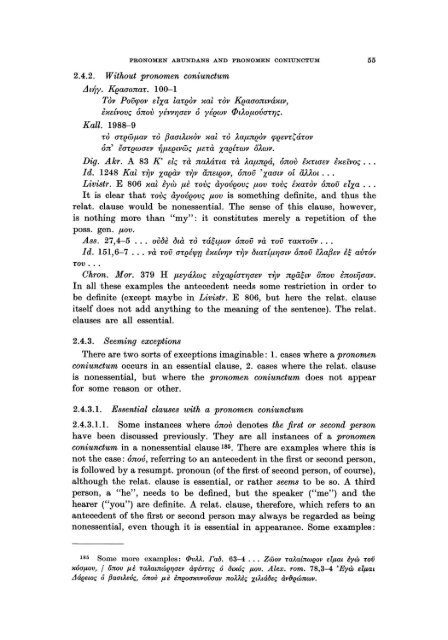Pronomen Abundans and Pronomen Coniunctum. A ... - DWC
Pronomen Abundans and Pronomen Coniunctum. A ... - DWC
Pronomen Abundans and Pronomen Coniunctum. A ... - DWC
Create successful ePaper yourself
Turn your PDF publications into a flip-book with our unique Google optimized e-Paper software.
PRONOMEN ABUNDANS AND PRONOMEN CONIUNCTUM<br />
2.4.2. Without pronomen coniunctum<br />
Ll1'l7Y. K(!aaonar. 100-1<br />
Tov Povrpov elXa lar(!ov ~ai<br />
È~dvovç onov yivv'Yjaev 0 yi(!wv C/>lÀoflovar'Yjç.<br />
KalI. 1988-9<br />
rov K(!aaontvá~lv,<br />
ro ar(!wflav ro f3aalÀl~ov ~ai ro Àafln(!ov rp(!evr'árov<br />
on' lar(!waev ~fle(!lVWç flerà Xa(!trwv oÀwv.<br />
Dig. Akr. A 83 K' elç rà naÀárta rà Àafln(!á, onov bmaev È~eïvoç . ..<br />
Id. 1248 Kai riJv Xa(!àv riJv linel(!OV, onov 'xaalv Ot MÀOl . ..<br />
Livistr. E 806 ~ai Èyw fli rovç àyov(!ovÇ flOV rovç lxarov onov elXa ...<br />
It is clear that rovç àyov(!ovÇ flOV is something definite, <strong>and</strong> thus the<br />
relat. clause would be nonessential. The sense of this clause, however,<br />
is nothing more than "my": it constitutes merely a repetition of the<br />
poss. gen. flOV.<br />
Ass. 27,4-5 ... oVlJè Ötà ro rá~lflov onov và rov ra~roVv ...<br />
Id. 151,6-7 ... và rov ar(!bpn È~etv'Yjv riJv btarlfl'YjGlV ónov lÀaf3ev È~ avróv<br />
rov . ..<br />
Chrono Mor. 379 H fleyáÀwç eVxa(!tar'Yjaev riJv n(!a~lV onov Ènolfjaav.<br />
In all these examples the antecedent needs some restrietion in order to<br />
be definite (except maybe in Livistr. E 806, but here the relat. clause<br />
itself does not add anything to the meaning of the sentence). The relat.<br />
clauses are all essential.<br />
2.4.3. Seeming exceptions<br />
There are two sorts of exceptions imaginable: I. cases where a pronomen<br />
coniunctum occurs in an essential clause, 2. cases where the relat. clause<br />
is nonessential, but where the pronomen coniunctum does not appear<br />
for some reason or other.<br />
2.4.3.1. Essential clause8 with a pronomen coniunctum<br />
2.4.3.1.1. Some instanees where onov denotes the first or second person<br />
have been discussed previously. They are all instanees of a pronomen<br />
coniuru:tum in a nonessential clause 185. There are examples where this is<br />
not the case: onov, referting to an antecedent in the first or second person,<br />
is followed by a resumpt. pronoun (of the fust of second person, of course),<br />
although the relat. clause is essential, or rather seems to be so. A third<br />
person, a "he", needs to be defined, but the speaker ("me") <strong>and</strong> the<br />
hearer ("you") are definite. Arelat. clause, therefore, which refers to an<br />
antecedent of the fust or second person may always be regarded as being<br />
nonessential, even though it is essential in appearance. Some examples:<br />
55<br />
185 Some more examples: tPvÀÀ. ra(j. 63-4 ... Zwov TaÀab'tw(!ov û",at Èyw TOV<br />
'XÓIJ",OV, / {Jnov ",è TaÀamW(!T}lJev àrpÉVTT}Ç Ó &'Xóç ",ov. Alex. rom. 78,3-4 'Eyw û",a,<br />
L1á(!etoç Ó f3alJ'Àevç, ónov ",è Èn(!olJ'XvvovlJav noÀUç X'À,á(jeç àv{)(!wnwv.
















